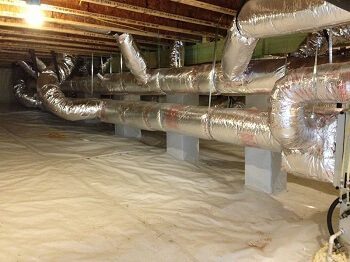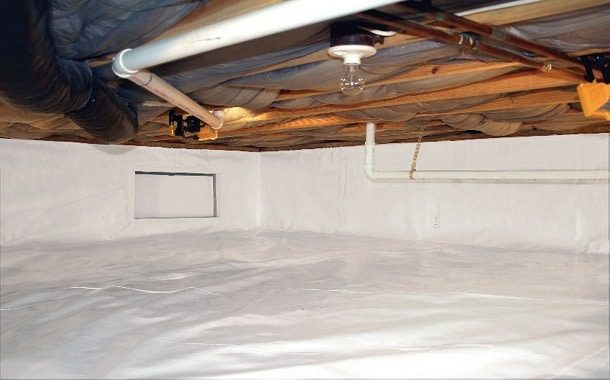How Much Crawl Space Encapsulation Cost?
Last Updated on February 20, 2024
Written by CPA Alec Pow | Content Reviewed by ![]() CFA Alexander Popinker
CFA Alexander Popinker
Crawl space encapsulation is an important home improvement project for homeowners dealing with moisture, mold, and pest issues in their crawl space. Encapsulating your crawl space involves installing a vapor barrier along with sealing vents, insulation, and a dehumidification system.
While crawl space encapsulation requires an initial investment, it offers long-term benefits in terms of health, energy efficiency, and added home value. If you’re considering encapsulating your crawl space, it’s helpful to understand the factors that influence the cost of crawl space encapsulation and what you can expect to budget for the project.
How Much Crawl Space Encapsulation Cost?
The average homeowner can expect to pay between $3,000 and $10,000 for a full professional crawl space encapsulation service. With the variables involved in crawl space encapsulation, it’s normal to see a wide price range for projects. However, prices ultimately come down to your specific space size, location, condition, and encapsulation system needs.
Some of the cost factors include:
- Materials – About $1.20 – $1.50 per sq ft for 6 mil polyethylene sheeting vapor barrier, sealing materials, insulation, plus dehumidifier unit.
- Labor – Around $3 to $6 per sq ft for contractor fees to install a vapor barrier, insulation, equipment, and perform any repairs.
- Mold remediation – This can range widely from $500 for minor spot treatment to $5000+ for extensive mold removal if needed.
- Structural repairs – Addressing any leaks, cracks, or rot issues will involve added costs for materials and contractor time.
- Excavation or drainage systems – Installing French drains or sump pumps can add $2000 – $5000.
Overall, most homeowners report paying $4000 – $9000 for full professional encapsulation service on a typical 1000 – 3000 sq ft crawl space. Costs scale up for larger spaces. The location also impacts pricing, with national averages around $6000. Get detailed estimates from local professionals for an accurate sense of encapsulation costs in your area.
According to Bob Vila costs range from around $1,500 for small crawl spaces up to as much as $15,000 for encapsulating a large crawlspace.
On the Angi website, they write that basic crawl space encapsulations cost between $2 and $4 per square foot, while more extensive encapsulations are between $3 and $10 per square foot. The average cost of crawl space encapsulation is $5,500, but it can cost between $1,500 and $20,000, depending on the crawl space’s size and condition.
Crawl Space Ninja reports a starter price for a basic encapsulation of $1,500 to $4,000.
Forbes notes that it generally costs between $2 and $4 per square foot to encapsulate a basement, for an average of about $3 per square foot.
According to This Old House website, the average cost of crawl space encapsulation is reported to be $5,500, with a range from $1,500 to $15,000, depending on the work required.
Factors Affecting the Cost of Crawl Space Encapsulation
Several variables affect the overall price range for encapsulation including the size and condition of your crawl space, the materials needed, and any additional services like mold remediation.
Crawl Space Size
The dimensions of your crawl space are a major cost determinant. Materials are priced per square foot for vapor barriers, insulation, sealing, etc. So, a larger crawl space will have a higher overall encapsulation cost. Professional quotes for crawl space encapsulation also factor in the size to estimate labor time.
Current Condition
The condition of your crawl space also impacts encapsulation pricing. If there is excessive moisture, leaks, or mold present, remediation work will add to costs prior to encapsulation. Addressing any structural issues like rotting wood or foundation cracks also adds expenses.
Materials Needed
The encapsulation system components – vapor barrier, insulation, dehumidifier, ventilation, and sealing materials – make up a significant portion of the cost. The quality of these materials used affects pricing as well.
Additional Services
Many encapsulation projects require added services like mold removal, leak repair, or installing Term drainage. Any supplementary needs will increase labor and material expenses for the total cost of encapsulating a crawl space.
Accessibility
Crawl space layout and accessibility impacts how long the project takes. Tight spaces require more work hours, which is factored into professional encapsulation costs. Ease of access lowers time and labor pricing.
The Costs of Crawl Space Encapsulation
To better understand encapsulation pricing, it helps to break the project into three main cost components – materials, labor, and any additional necessary services.
Encapsulation Materials
 The materials make up a significant portion of your total encapsulation expense. These include:
The materials make up a significant portion of your total encapsulation expense. These include:
- Vapor barrier – Polyethylene sheeting costs around $100 – $150 per 100 sq ft roll. $1 to $1.5 per sq ft installed.
- Sealing materials – About $200 – $500 on average for sealants, gap fillers, and fasteners to adhere to the vapor barrier.
- Insulation – Fiberglass batts around $0.50 to $1 per sq ft. Rigid foam boards $1 – $1.50 per sq ft.
- Dehumidifier – HVAC unit averages $2000 – $3000 depending on the capacity needed.
- Ventilation – Humidity-controlled grilles $100 – $300.
- Waterproofing compounds – For leaks or seams, approx. $0.50 to $2 per sq ft applied.
So, for a 1000 sq ft crawl space, homeowners may spend around $2500 – $4000 on all encapsulation materials.
Labor Expenses for Installation & Repairs
Professional contractor fees make up a large share of encapsulation costs. Rates range from $3 – $6 per square foot for installation labor depending on location. For a 1000 sq ft space, that equates to $3000 – $6000 in labor. Any repair work like fixing cracks or leaks also adds contractor hours at $50 – $100 per hour.
Additional Services
As outlined above, expenses for any supplementary services will add to the total encapsulation price:
- Mold remediation – from $500 for minor to $5000+ for major mold removal
- Structural repairs – $200 – $1000+ per issue
- Drainage system – French drain around $2000 – $5000
- HVAC upgrades – Improved ventilation $1000 – $2000
When budgeting, account for about 10% – 30% more on top of base encapsulation costs to cover any extra services needed.
The Value of Encapsulation Against the Costs
Crawl space encapsulation requires a significant upfront investment for most homeowners. However, it’s important to weigh the costs against the long-term benefits when deciding on this project.
Energy Efficiency and Savings
A properly sealed, insulated, and dehumidified crawl space prevents conditioned air leaks and drafts. This can reduce overall heating and cooling costs by 10% to 20% per year, saving $100 – $400 annually for most homes.
Healthier Home and Improved Air Quality
Controlling moisture and sealing gases/pests in the crawl space improves indoor air quality and protects family health, especially for issues like allergies and asthma.
Added Home Value
Encapsulation enhances your home’s foundation integrity and prevents further moisture damage. This boosts property value by $1,000 – $4,000 on average according to home appraisers.
You might also like our articles on the cost of a Bath fitter, pier and beam foundation, or Porta Potty rental.
Pest Prevention
Keeping your crawl space unconditioned deters termites, ants, rodents, and other pests from nesting. This avoids major repair costs down the line.
Over 5-10 years, most homeowners get a full ROI on their encapsulation investment through added savings, health benefits, and property value enhancement.
Hiring a Professional
Because encapsulation requires specialized materials, equipment, and labor, hiring a qualified contractor is highly recommended. Here are tips for finding the right encapsulation pro:
- Get quotes from 2-3 encapsulation specialists in your area for a cost comparison
- Verify they are properly licensed, insured, and have training credentials
- Ask about their crawl space encapsulation experience, years in business
- Request references from past clients you can contact
- Confirm they will provide a detailed inspection before quoting
- Get clearly outlined price estimates in writing before signing a contract
When sourcing quotes, look for detailed breakdowns on materials, labor rates, timeline, and any containment needed. Avoid very lowball bids that seem too good to be true. With the right contractor, you can rest assured your investment into encapsulation will pay dividends.
Final Words
Adding full encapsulation in your crawl space averages between $4000 – $9000 professionally installed. Exact pricing depends on your space size, location, existing conditions, and any extra needs like mold removal. While not cheap, encapsulation offers many long-term benefits beyond the upfront cost.
For most homeowners, crawl space encapsulation provides energy savings, added home value, and most importantly – improved indoor air quality and family health. Addressing moisture in your crawl space through encapsulation can transform your home’s comfort, safety, and foundation integrity for years to come.
Frequently Asked Questions
What are the negatives of crawl space encapsulation?
Some potential drawbacks of encapsulation include:
- High upfront cost for materials and professional installation
- Ongoing electricity costs for dehumidifier operation
- Risk of new moisture issues if not properly maintained
- Makes future access to utilities in crawl space more difficult
- Can require HVAC adjustments for proper air circulation
Does crawlspace encapsulation cause mold?
Encapsulation should not cause mold growth if done correctly. The purpose of encapsulation is to prevent and control moisture that contributes to mold in a crawl space. However, if there are any existing moisture or leaks not properly addressed prior to encapsulation, it could potentially worsen mold issues.
Proper remediation of any mold plus sealing, climate control, and drainage should all be part of the encapsulation process to prevent future mold growth.
What is the alternative to crawl space encapsulation?
Some alternatives to full encapsulation include:
- Localized dehumidification units – Less expensive than full HVAC integration
- Plastic sheeting or vapor barriers – Partial moisture protection
- Improved crawl space ventilation – Can aid moisture control through airflow
- Drainage systems – French drains or sump pumps to remove water
- Regular dehumidifier use – Lowers humidity levels periodically
However, most experts recommend full encapsulation for the best long-term crawl space moisture, mold, and pest control. Partial fixes are typically less effective.
Is crawl space encapsulation worth the money?
For most homeowners with persistent moisture or humidity issues in their crawl space, encapsulation is a smart investment well worth the cost. Paying more upfront for full professional encapsulation will prevent far more expensive repairs needed from water damage, mold growth, and pests over time.
Properly encapsulating your crawl space will lead to energy savings, improved indoor air quality, and added comfort and health benefits for your family. Considering long-term savings and home value enhancement, encapsulation ultimately pays for itself in the majority of cases.


Leave a Reply
Want to join the discussion?Feel free to contribute!